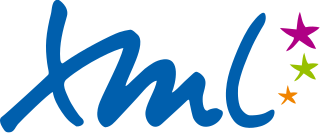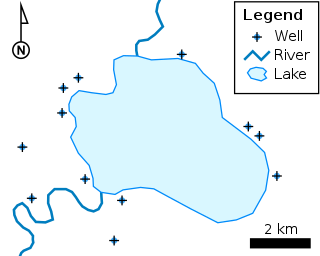The Lightweight Directory Access Protocol is an open, vendor-neutral, industry standard application protocol for accessing and maintaining distributed directory information services over an Internet Protocol (IP) network. Directory services play an important role in developing intranet and Internet applications by allowing the sharing of information about users, systems, networks, services, and applications throughout the network. As examples, directory services may provide any organized set of records, often with a hierarchical structure, such as a corporate email directory. Similarly, a telephone directory is a list of subscribers with an address and a phone number.

Extensible Markup Language (XML) is a markup language that defines a set of rules for encoding documents in a format that is both human-readable and machine-readable. The World Wide Web Consortium's XML 1.0 Specification of 1998 and several other related specifications—all of them free open standards—define XML.
The Organization for the Advancement of Structured Information Standards is a global nonprofit consortium that works on the development, convergence, and adoption of open standards for cybersecurity, blockchain, Internet of Things (IoT), emergency management, cloud computing, legal data exchange, energy, content technologies, and other areas.

The Geography Markup Language (GML) is the XML grammar defined by the Open Geospatial Consortium (OGC) to express geographical features. GML serves as a modeling language for geographic systems as well as an open interchange format for geographic transactions on the Internet. Key to GML's utility is its ability to integrate all forms of geographic information, including not only conventional "vector" or discrete objects, but coverages and sensor data.
Security Assertion Markup Language is an open standard for exchanging authentication and authorization data between parties, in particular, between an identity provider and a service provider. SAML is an XML-based markup language for security assertions. SAML is also:
Service Provisioning Markup Language (SPML) is an XML-based framework, being developed by OASIS, for exchanging user, resource and service provisioning information between cooperating organizations.
Universal Business Language (UBL) is an open library of standard electronic XML business documents for procurement and transportation such as purchase orders, invoices, transport logistics and waybills. UBL was developed by an OASIS Technical Committee with participation from a variety of industry data standards organizations. UBL is designed to plug directly into existing business, legal, auditing, and records management practices. It is designed to eliminate the re-keying of data in existing fax- and paper-based business correspondence and provide an entry point into electronic commerce for small and medium-sized businesses.
XML Enabled Directory (XED) is a framework for managing objects represented using the Extensible Markup Language (XML). XED builds on X.500 and LDAP directory services technologies.
Catalogue Service for the Web (CSW), sometimes seen as Catalogue Service - Web, is a standard for exposing a catalogue of geospatial records in XML on the Internet. The catalogue is made up of records that describe geospatial data, geospatial services, and related resources.
Microsoft Identity Integration Server (MIIS) is an identity management (IdM) product offered by Microsoft. It is a service that aggregates identity-related information from multiple data-sources. The goal of MIIS is to provide organizations with a unified view of a user's/resources identity across the heterogeneous enterprise and provide methods to automate routine tasks.

The Open Grid Forum (OGF) is a community of users, developers, and vendors for standardization of grid computing. It was formed in 2006 in a merger of the Global Grid Forum and the Enterprise Grid Alliance. The OGF models its process on the Internet Engineering Task Force (IETF), and produces documents with many acronyms such as OGSA, OGSI, and JSDL.
Security Assertion Markup Language (SAML) is an XML standard for exchanging authentication and authorization data between security domains. SAML is a product of the OASIS (organization) Security Services Technical Committee.
Election Markup Language (EML) is an XML-based standard to support end to end management of election processes.
Content Assembly Mechanism (CAM) is an XML-based standard for creating and managing information exchanges that are interoperable and deterministic descriptions of machine-processable information content flows into and out of XML structures. CAM is a product of the OASIS Content Assembly Technical Committee.
The Office Open XML file formats are a set of file formats that can be used to represent electronic office documents. There are formats for word processing documents, spreadsheets and presentations as well as specific formats for material such as mathematical formulae, graphics, bibliographies etc.
Data Format Description Language, published as an Open Grid Forum Proposed Recommendation in January 2011, is a modeling language for describing general text and binary data in a standard way. A DFDL model or schema allows any text or binary data to be read from its native format and to be presented as an instance of an information set.. The same DFDL schema also allows data to be taken from an instance of an information set and written out to its native format.

Json2Ldap is a JSON-to-LDAP gateway software, written in Java and developed by Nimbus Directory Services. It provides a JSON-RPC 2.0 interface for web clients to access one or more LDAP v3 - compatible directories. The Json2Ldap web API supports the standard LDAP directory requests as well as several extended operations and controls.
The SAML metadata standard belongs to the family of XML-based standards known as the Security Assertion Markup Language (SAML) published by OASIS in 2005. A SAML metadata document describes a SAML deployment such as a SAML identity provider or a SAML service provider. Deployments share metadata to establish a baseline of trust and interoperability.